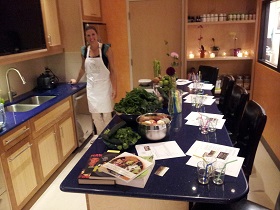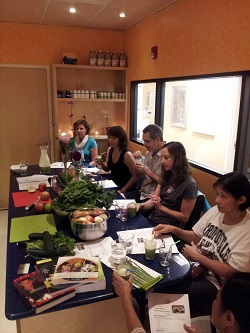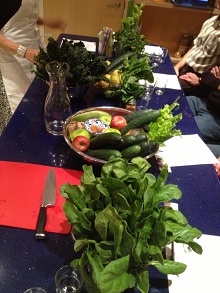 “If you are not your own doctor, you are a fool.” -Hippocrates
“If you are not your own doctor, you are a fool.” -Hippocrates“People don’t get it. They think the answer is a pill.” It’s not a pill, it’s a plant — lots of plants.” -Rip Esselstyn
If you are not experiencing vibrant health, diet is your first place to look for change. A mostly raw foods diet can change your life.
By popular demand, I taught another juicing class last week in the Coda Health Kitchen in Dental Health of Boulder. Only this time with a twist. I called it: Learn to Juice for a Healthier Life. I love teaching juicing classes because as time goes on, people become more educated on all of the benefits of juicing. Juicing is not some “weird fad diet” or considered “extreme” any longer. Finally, we are taking charge of our own health… and realizing that green juice actually tastes great!
I decided to give juicing a real go after watching the film Fat Sick and Nearly Dead. I figured, as someone striving to be a successful Health Consultant at Boulder’s Coda Health Kitchen, it might not be a bad idea to drink and create recipes that taste good for people with a low tolerance to plants, or someone just getting started with juicing. So I began to experiment with making juices for patients here at Dental Health of Boulder. We have freshly made juices and organic smoothies that we make here for our patients, as well as a whole array of complimentary amenities to help the patients here have the ultimate dental experience.
Juicing is such a wonderful way to improve your health and help maintain a nutritious raw lifestyle. While giving nutritional counseling, I am often asked to name one thing that can be done right away to improve health. With respect to food choices, the best suggestion I give is to drink freshly pressed green vegetable juices. Drinking just one green juice each day is a reliable way of infusing your body with a wide variety of vitamins, minerals, and phytonutrients that can protect your cells against premature aging and disease.
 I personally find that summer is the best time to detox your body with juicing. With the warmer weather, I find it much easier to drink vegetable juices for a lot of meals or have a green juice smoothie. In fact, a green juice is often times my breakfast. It is exactly what I need first thing in the morning: spinach, kale, lemon, apple cider vinegar, pear, green apples and celery. Morning green juicing gives me energy to start the day, gives me a good dose of raw food and high nutrients, I sleep better and have a good regular digestion. All of this combined does bring mental clarity and good overall health.
I personally find that summer is the best time to detox your body with juicing. With the warmer weather, I find it much easier to drink vegetable juices for a lot of meals or have a green juice smoothie. In fact, a green juice is often times my breakfast. It is exactly what I need first thing in the morning: spinach, kale, lemon, apple cider vinegar, pear, green apples and celery. Morning green juicing gives me energy to start the day, gives me a good dose of raw food and high nutrients, I sleep better and have a good regular digestion. All of this combined does bring mental clarity and good overall health.
One thing I always stress to people is to make the bulk of your juice be comprised of leafy greens. Spinach and kale are my personal favorites for many reasons. Also, it is easy and cheap to use Dandelion greens which can come directly from your yard. Not only do they provide a higher amount of calcium and iron than most cultivated greens, but they have a wide array of health benefits that make them the perfect all around nutritional boost. Read more about benefits of dandelion greens here.
You may be asking, “What is it about leafy greens that are so beneficial?” Leafy greens are packed with chlorophyll and antioxidants which helps the body to heal. I went crazy with the kale the other day and it went really well with some celery, green apple and red grapefruit. The juice was a great combo; it was the right amount of each to make a very easy and enjoyable juice to drink.
The quantities were, 2 big handfuls of kale, 5 stalks of celery (including leafy ends), 1 green apple (de-seeded as the seeds are toxic) and 1 red grapefruit (peeled, but leave as much as the white ‘skin’ on as possible). You can also add a teaspoon of spirulina in your juice for an extra dose of vegetable protein and goodness. Spirulina which helps remove toxins from the blood and boost the immune system. Spirulina contains vitamins B-1(thiamine), B-2 (riboflavin), B-3(nicotinamide), B-6 (pyridoxine), B-9 (folic acid), vitamin C, vitamin D, vitamin A and vitamin E. It is also a source of potassium, calcium, iron, magnesium, phosphorus, selenium and zinc.
Kale has wonderful nutritional value. Kale is considered to be a highly nutritious vegetable with powerful antioxidant properties and is anti-inflammatory. Kale is very high in beta carotene, vitamin K, vitamin C, lutein, etc. and is rich in calcium.
So go crazy with kale!
Did you know that you can juice fennel? It’s true. Fennel is great for the stomach and digestion and particularly high in calcium. Other health benefits of fennel are its ability to calm intestinal colic and spasms, and ease abdominal pain and discomfort. In herbal medicine it is used for nausea, diarrhea, flatulence, difficult lactation, period pain, bronchial coughs and IBS. Enjoy this super simple and satisfying fennel juice today!
Ingredients:
2 fennel bulbs
2 celery stalks
1 – 2 apples (I always recommend and prefer juicing green apples. It’s lower in sugar and Green apple juice has a slight pucker as compared to the sweet taste of red apple juice.
1 lime
In the juicing class, we also talked all about juicing vs. blending.
What I most wanted the attendees to take home from my class was this: Drinking fresh juice can help us adopt healthier eating  patterns. For those of us who do not traditionally consume a ton of fruits and vegetables, incorporating fresh juice can be a fun and different approach to increasing consumption of these important plant foods for improved health and wellness and reaching your weight loss goals. Here is a recipe I like to recommend for people just starting to juice. It’s both simple and delicious.
patterns. For those of us who do not traditionally consume a ton of fruits and vegetables, incorporating fresh juice can be a fun and different approach to increasing consumption of these important plant foods for improved health and wellness and reaching your weight loss goals. Here is a recipe I like to recommend for people just starting to juice. It’s both simple and delicious.
4 carrots
1 cucumber
1-2 cups of spinach
1 lemon
1 gala or pink lady apple
1 pear
If you missed my juicing classes and are interested in juicing, keep in mind the following juicing basics:
– choose organically grown produce for greater nutritional density and to avoid pesticides and genetically modified foods. If you can’t get organic, wash thoroughly with a vegetable wash, peel and avoid anything that is known to be heavily sprayed (strawberries, blueberries, spinach, bell peppers, etc.) or cannot be peeled (like berries).
– Peel oranges & grapefruits. These skins contain a toxic substance and taste bitter. Leave some of the thick white inside part of the peel since it is rich in bioflavonoids & vitamin C. Always peel imported tropical fruits since they are usually sprayed with chemicals. Peel any fruits or veggies that have been waxed.
– Remove pits before juicing. Seeds can be juiced, except for apple seeds which can be toxic in large quantities.
– Be sure to juice all the stems and leaves with your fruits & vegetables – they are rich in nutrients and are alkaline forming (except carrot and rhubarb greens which are toxic).
 – Prepare your fruits and vegetables in advance by chopping to fit the mouth of your juicer. For single auger juicers like the Samson, chop hard vegetables (carrots) into smaller or thinner pieces so they go through easier.
– Prepare your fruits and vegetables in advance by chopping to fit the mouth of your juicer. For single auger juicers like the Samson, chop hard vegetables (carrots) into smaller or thinner pieces so they go through easier.
– Don’t juice produce that is low in water content, like bananas and avocados. You can add these ingredients later in a blender.
– Drink juice on an empty stomach for best nutrient absorption. Remember to “chew” your juices – as we say here at Dental Health of Boulder, digestion starts in the mouth!
– As nutritious and delicious as juice is, it is not a good idea to use it as an ongoing meal replacement (except during a controlled cleanse or detox).
– Get a quality juicer that is easy to use and clean. If it is difficult and time-consuming to use you might not use it. I personally love my Breville juicer. But here is a list of others that work well: Juicer List.
We hope you benefit from the information presented here. Our goal at Dental Health Colorado is to include nutrition and diet as part of the consideration of your dental health. Please leave us any comments if you would like more information.